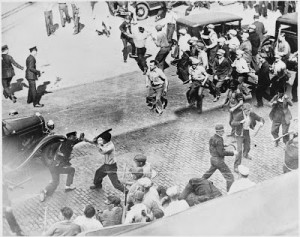Posted: May 15, 2015
Source: Teamster Nation
 It was springtime in Minneapolis during a year when the American labor movement was making itself known in radical fashion throughout the country. The year was 1934, a time when labor unrest was not simply defined by strikes and civil disobedience. Police batons were wielded at workers, live ammunition was fired, National Guard troops were deployed, blood was spilled and lives were lost.
It was springtime in Minneapolis during a year when the American labor movement was making itself known in radical fashion throughout the country. The year was 1934, a time when labor unrest was not simply defined by strikes and civil disobedience. Police batons were wielded at workers, live ammunition was fired, National Guard troops were deployed, blood was spilled and lives were lost.
And Teamsters were at the center of it all.
On May 15, 1934, the 6,000 members of Teamsters Local 574 in Minneapolis voted to strike all trucking employers, demanding recognition and wage increases. The vote signaled an escalation in what some remember as the “Teamster Rebellion,” a wave of strikes that nearly shut down the city and put the still-young Teamsters Union at the forefront of organized labor.
The general truckers’ strike vote on May 15 followed a Teamster strike in February that shut down almost all the coal yards. The demand for coal in the winter brought a quick end to the strike, securing a rise in membership for Local 574.
The militant organizing agenda of Local 574 was inspired largely by the leadership of the union such as Carl Skoglund. Having recruited others, including Farrell Dobbs and Grant and Miles Dunne, into a large organizing committee, the union sought to build on the momentum of the coal yard strike by preparing for a general strike.
In the wake of the Great Depression with unemployment still high, the challenge of using strikes was plain to see. That’s why Local 574 partnered with Minneapolis unemployed organizations to win the support of jobless residents before the strike. It also teamed up with the Minnesota Farm-Labor Party.
— Read the complete source story.
[divider_top]
